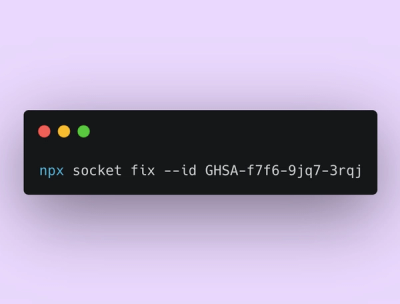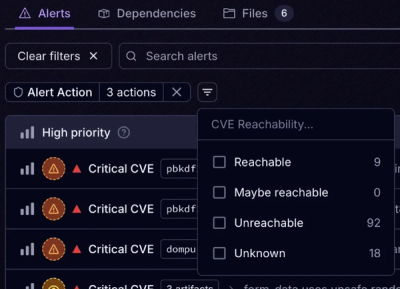
Product
Announcing Socket Fix 2.0
Socket Fix 2.0 brings targeted CVE remediation, smarter upgrade planning, and broader ecosystem support to help developers get to zero alerts.
@mittwald/api-models
Advanced tools
This package contains a collection of domain models for coherent interaction with the mittwald API.
Copyright (c) 2023 Mittwald CM Service GmbH & Co. KG and contributors
This project (and all NPM packages) therein is licensed under the MIT License; see the LICENSE file for details.
You can install this package from the regular NPM registry:
yarn add @mittwald/api-models
You will need to initialize an API client in order to operate with the models
provided by this package. Use the api global instance for initialization with
some methods.
import { api } from "@mittwald/api-models";
api.setupWithApiToken(process.env.MW_API_TOKEN);
Reference or ReferenceModel represents a certain model just by its
ID.DetailedModel contains all the data of the resource.For a more detailed description refer to the section Type of models
// Get a detailed project
const detailedProject = await Project.get("p-vka9t3");
// Create a project reference
const projectRef = Project.ofId("p-vka9t3");
// Get the detailed project from the reference
const anotherDetailedProject = await projectRef.getDetailed();
// Update project description
await detailedProject.updateDescription("My new description!");
// This method just needs the ID and a description and
// thus is also available on the reference
await projectRef.updateDescription("My new description!");
// Accessing the projects server reference
const server = project.server;
// List all projects of this server
const serversProjects = await server.projects.execute();
// List all projects
const allProjects = await Project.query().execute();
// Iterate over project List Models
for (const project of serversProjects) {
await project.leave();
}
This package also provides methods aligned to be used in React components. It uses @mittwald/react-use-promise to encapsulate all asynchronous functions into AsyncResources. More details about how to use AsyncResources see the package documentation.
To use the React client you have to install the additional
@mittwald/react-use-promise package:
yarn add @mittwald/react-use-promise
All asynchronous methods provide a use-method property. This method uses
@mittwald/react-use-promise
under the hood to "resolve" the promise in the "React way".
const detailedProject = Project.get.use("p-vka9t3");
// Create a project reference
const projectRef = Project.ofId("p-vka9t3");
// Get the detailed project from the reference
const anotherDetailedProject = projectRef.getDetailed.use();
// Accessing the projects server reference
const server = project.server;
// List all projects of this server
const serversProjects = server.projects.execute.use();
// List all projects
const allProjects = Project.query().execute.use();
Most of all models provided by this package represent an associated counter-part in the backend. When a model is loaded from the backend, the current state is incorporated into the model instance. To keep it simple and predictable this state is immutable and does not change under any circumstances. As a result you must create a new instance to get an updated model and propagate it throughout the runtime code.
This also applies for operations initiated at client-side. For example when the
updateDescription method is called on a project, the project instance will
still have the old description.
"Watching for changes" is not scope of this package and will be implemented in future releases or other packages™️.
As a general advice when contributing, be sure to look at the existing source code and use it as a template!
Please consider the following conventions when adding or modifying models.
Structure the models in meaningful directories.
Models should extend (or inherit) the correct base class. You can find the base
classes in src/base. The following classes are available.
DataModelThe DataModel is the foundation of all model classes that contain a set of immutable generic data.
ReferenceModelA ReferenceModel represents a certain model just by its ID. As the most basic model operations often just need the ID and some input data (deleting, renaming, ...), Reference Models can avoid unnecessary API round trips.
When adding models or methods pay close attention to the (maybe existing) language used in the respective domain. Talk to the responsible team if you are uncertain.
Models should cover the following aspects:
The response type for some models often differs when loading single items or
lists. To reduce the amount of data, the list response type is usually a subset
of the comprehensive model. Add separate classes for the Detailed Model (name it
[Model]Detailed) and the List Model (name it [Model]ListItem).
If both model share a common code base, you should add a Common Model (name it
[Model]Common).
A Reference Model represents a certain model just by its ID. As the most basic model operations often just need the ID and some input data (deleting, renaming, ...), Reference Models can avoid unnecessary API round trips. These classes should be used as a return type for newly created models or for linked models.
To get the actual Detailed Model, Reference Models must have a
function getDetailed(): Promise<ModelDetailed> and
function findDetailed(): Promise<ModelDetailed|undefined> method.
Consider extending the Reference Model when implementing the Entry-Point Model.
Querying models usually requires a query object – or short query. The query
mostly includes pagination settings like limit, skip or page. It may also
include filters like fromDate or toDate, and filters to other models like
customerId.
A Query Model represents a specific query to a specific model and should include the following methods:
execute(): executes the query and returns the respective List Modelrefine(overrideQuery): creates a new Query Model with a refined query objectgetTotalCount(): gets the total count of the query (executes the query with
limit: 0)When a model supports queries, it should provide a static query() method to
create the respective Query Model.
When a model is used as a query parameters in a Query Model, the model should have a property in its Reference Model for this Query Model. See the following example:
class Server {
public readonly projects: ProjectsListQuery;
public constructor(id: string) {
this.projects = new ProjectListQuery({
server: this,
});
}
}
List Models are the result of a Query Model execution. A List Model includes
List Models should extend their respective Query Model, because it might be
helpful to also call refine() on an already executed query.
When implementing shared functionality, like in the Common Models, you can use
the polytype library to realize
dynamic multiple inheritance. Be sure to look at the existing source code for
implementation examples.
Provide a single model (name it [Model]) as an entry point for all different
model types (detailed, query, ...). As a convention provide a default export for
this model.
findEntry-Point models should have a static find method. The find method returns
the detailed model or may return undefined if the model can not be found.
getIn addition to the find method Entry-Point models should have a static get
method. The get method should return the desired object or throw an
ObjectNotFoundError. You can use the find method and assert the existence
with the assertObjectFound function.
queryWhen a list of objects should be queried use a query method. It may support a
query parameter to filter the result by given criteria.
createWhen a model should be created use a static create method. This method should
return a reference of the created resource.
Most of the models are part of a larger model tree. Models should provide
properties to get the parent and child models, like project.server,
server.projects or server.customer.
If a linked model provides a Reference Model or Entry-point Model, create it in the model constructor, to avoid unnecessary API round trips.
Models are usually backed by a set of behaviors, defining the basic model interactions. In order to actually "use" the model, it must be initialized with a concrete behavior implementation. This layer of abstraction removes implementation specific code from the model, and also makes behaviors exchangeable without any impact on the model itself - for example inside unit tests.
Consider using behaviors for:
Encapsulate any API interaction inside the model behaviors to prevent strong coupling of model and API-specific implementation.
class ProjectDetailed {
public static async find(
id: string,
): Promise<ProjProjectDetailed | undefined> {
const response = await client.project.getProject({
id,
});
if (response.status === 200) {
return new Project(response.data.id, response.data);
}
assertStatus(response, 403);
}
}
class ProjectDetailed {
public static async find(id: string): Promise<ProjectDetailed | undefined> {
const data = await config.project.behaviors.find(id);
if (data !== undefined) {
return new Project(data.id, data);
}
}
}
Place a behaviors folder inside the model that should look like this:
Project/
├─ behaviors/
│ ├─ index.ts
│ ├─ types.ts (behavior interface)
│ ├─ api.ts (behavior implementation)
│ ├─ inmem.ts (behavior implementation)
types.ts firstIt is a good starting point to first implement the interface for the behavior. The interface usually just defines methods used in the behavior. Like
export interface ProjectBehaviors {
find: (id: string) => Promise<ProjectData | undefined>;
updateDescription: (projectId: string, description: string) => Promise<void>;
}
Then register the behavior in the global behavior configuration
packages/models/src/config/config.ts.
If the behavior interface is defined, you can start implementing the model. You can also first implement the concrete API behavior, to "proof" the behavior is "working" with the real API.
import { config } from "../../config/config.js";
class ProjectDetailed {
public static async find(id: string): Promise<ProjectDetailed | undefined> {
const data = await config.project.behaviors.find(id);
if (data !== undefined) {
return new Project(data.id, data);
}
}
}
The API behavior depends on an API client. You can implement the behavior as an object factory, or a simple class implementing the interface. When using the object factory, you do not have to redeclare the method parameter types.
Do the implementation specific stuff, thus preparing and executing the request, and finally processing the response.
import { ProjectBehaviors } from "./types.js";
import { assertStatus, MittwaldAPIV2Client } from "@mittwald/api-client";
export const apiProjectBehaviors = (
client: MittwaldAPIV2Client,
): ProjectBehaviors => ({
find: async (id) => {
const response = await client.project.getProject({
projectId: id,
});
if (response.status === 200) {
return response.data;
}
assertStatus(response, 403);
},
});
All asynchronous methods should provide a use-method property. This method
uses
@mittwald/react-use-promise
under the hood to "resolve" the promise in the "React way".
To provide this feature to your async model methods, wrap the actual method
with the provideReact enhancer.
class ProjectDetailed {
public static find = provideReact(
async (id: string): Promise<ProjectDetailed | undefined> => {
const data = await config.behaviors.project.find(id);
if (data !== undefined) {
return new ProjectDetailed(data);
}
},
);
}
FAQs
Collection of domain models for coherent interaction with the API
We found that @mittwald/api-models demonstrated a healthy version release cadence and project activity because the last version was released less than a year ago. It has 4 open source maintainers collaborating on the project.
Did you know?

Socket for GitHub automatically highlights issues in each pull request and monitors the health of all your open source dependencies. Discover the contents of your packages and block harmful activity before you install or update your dependencies.

Product
Socket Fix 2.0 brings targeted CVE remediation, smarter upgrade planning, and broader ecosystem support to help developers get to zero alerts.

Security News
Socket CEO Feross Aboukhadijeh joins Risky Business Weekly to unpack recent npm phishing attacks, their limited impact, and the risks if attackers get smarter.

Product
Socket’s new Tier 1 Reachability filters out up to 80% of irrelevant CVEs, so security teams can focus on the vulnerabilities that matter.